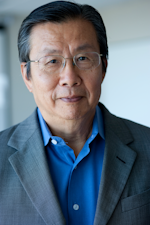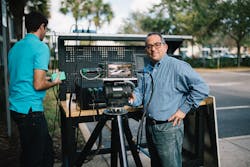Business Forum: Photonics entrepreneurship meets demand for autonomous vehicle lidar
This month, I interviewed Dr. Jason Eichenholz, CTO and co-founder of Luminar Technologies. The company is developing high-performance light detection and ranging (lidar) for autonomous vehicles. I jumped at the opportunity because self-driving cars is a hot topic of current interest.
Milton Chang: When do you think we can buy cars that can perform all the functions a human driver can?
Jason Eichenholz: This is defined as Level 5 by the National Highway Traffic Safety Administration (NHTSA).
Sensor performance and perception is the main limiting factor in making this a reality. I think we can easily foresee having safe, semi-autonomous vehicles by 2021. We believe Luminar will accelerate the deployment of safe Level 5 autonomous vehicles by at least five years.
MC: Describe your product.
JE: Our product is a new type of lidar that allows autonomous vehicles to see and understand the world in 3D (see this article for more information). A self-driving car needs to be more than 99% reliable, and it’s the last 1% of cases that is an order of magnitude more difficult to solve. There is no other technology that has the accuracy and the range to make self-driving cars safe in all circumstances.
MC: How do you differentiate?
JE: Our lidar solution is able to see up to 50X higher resolution and 10X farther range than some of the best-performing lidar systems deployed. This means that we can see 10% reflectivity (dark) objects at 200+ m to offer over seven seconds of reaction time at highway speeds. Systems today can only see dark objects at about 30 m or so.
MC: What do you do differently?
JE: Every aspect of our design is customized from the chip level up to achieve the highest level of performance. Lidar systems deployed on cars today operate at 905 nm, which has limitations in range and resolution due to eye safety. We operate at 1550 nm inside the "eye-safe" region, which allows us to emit 40X the laser power and still be Class 1 eye-safe. We had to build all of our own components, including the laser, receiver, scanning mechanisms, and the processing electronics. We figured out how to cost-effectively utilize InGaAs detectors and leverage low-cost telecom components in our lasers to meet both the performance and scalability required. We do all of this using just one laser and one receiver, and get better performance than using an array of 64 lasers and 64 receivers—and still meet required cost targets.
MC: Are you implying you'll be able to compete on price?
JE: There are multiple companies saying they will be able to eventually offer sensors at the $100 mark. With that low cost comes dramatic reductions in performance. We are not in a race to the bottom—instead, we focus first and foremost on providing the highest-quality data customers need to safely operate a self-driving vehicle, yet still easily meet customers’ price requirements.
MC: How close are you to shipping products?
JE: We've already been shipping products to customers out of our 70,000-sq-ft. facility in Orlando. We're in the midst of a 100-unit run of our current product series. We start our next-generation run of 10,000 units later this year, with deliveries also beginning later this year.
MC: There's a lot of Level 4 and 5 cars projected to be on the road in 2021. How do you anticipate meeting these demands?
JE: Luminar has partnered with four major autonomous vehicle programs that are currently testing our lidar systems. But we will quickly be moving to scale to 10,000 units starting later this year. What's great is we hear often from our customers that within the foreseeable future, they would like to purchase all of the units that we can produce.
MC: That's rare for a startup. What made you choose to locate your plant in Orlando—to be in the vicinity of CREOL?
JE: It starts with the people and the quality of the talent in Orlando—and UCF/CREOL was the reason we located our R&D, engineering, and manufacturing here. There is the highest concentration of lidar expertise in the world within a 10-mile radius of our building. Between Lockheed Martin, Northrop Grumman, Harris, L3, and the Kennedy Space Center, there is a huge infrastructure and pool of talent. I was able to quickly put together a team with more than 700 years of combined lidar experience, including controls engineers, lasers, and receivers.
MC: Can aerospace engineers design cost-effective products that can be produced in consumer volumes? The automotive industry is reputed to be very cost-sensitive.
JE: Right now, we're making a transition from an R&D-focused company into a global supplier of lidar with substantial manufacturing efforts. And with that comes a few additional resources we’re bringing on.
MC: Locating in Orlando is a smart move! The costs in Silicon Valley are no doubt much higher than in Orlando.
JE: Yes. Real estate, pay scale, and turnover is more rational, too. We brought a little bit of Silicon Valley to Orlando, and we are bringing a little bit of Orlando to Silicon Valley.
MC: Do you get any subsidies from local governments?
JE: No, we have not asked the state or local governments for any subsidies. We raised $36 million in seed funding over five years from a number of sources, including Canvas Ventures, GVA Capital, and 1517 Fund.
MC: You make it sound easy!
JE: It always sounds easy after the fact. We've been extremely cost-efficient, and at the same time have had real products to show both customers and investors. We also spent five years keeping the company in stealth mode to lock up our IP and supply chain, which was the hard part.
MC: I have known you for a long time, and now you are on your way to becoming a major success. How did you do it?
JE: My mantra is "hire people smarter than you." My career started on the technology side as a PhD research scientist, and being PI on DARPA SBIRs and Air Force STTRs. I got into the commercial side by doing strategic marketing at Newport, where I was lucky enough to meet a lot of great people. Then, I was the CTO at Ocean Optics, and from there started Open Photonics to be able to think outside of the box to deliver products to solve unmet market needs.
MC: What makes you do that at the philosophical level?
JE: My advice is to go out and build social capital, which means doing things for other people, providing service to the industry and other groups without the expectation of being paid back. For example, volunteer for OSA or SPIE committees. This can be as simple as helping a fellow graduate student get an experiment done.
MC: Sounds pretty much like the "give-to-get" philosophy I have been promoting.
JE: It is similar, and my dad always taught me to find the win-win. Newport, Ocean Optics, and Spectra-Physics each funded some of my research while in grad school, and I was helping them because I was genuinely interested in the work. Now, it's funny that I ended up working at each of those amazing companies. Every single job I have had is because of someone who knew me or knew my work. That is social capital, when someone is willing to give you a job because you have helped them in the past.

Milton Chang
MILTON CHANG of Incubic Management was president of Newport and New Focus. He is currently director of mBio Diagnostics and Aurrion; a trustee of Caltech; a member of the SEC Advisory Committee on Small and Emerging Companies; and serves on advisory boards and mentors entrepreneurs. Chang is a Fellow of IEEE, OSA, and LIA. Direct your business, management, and career questions to him at [email protected], and check out his book Toward Entrepreneurship at www.miltonchang.com.
